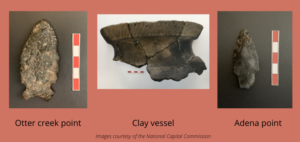Thousand-Year-Old Artifacts to Be Analyzed, Cleaned and Catalogued at Algonquin College
Posted on Friday, September 24th, 2021
 Pre-contact Indigenous artifacts discovered in Vincent Massey Park have been brought to the Algonquin College campus for analyzing, cleaning, and recording as part of a larger project involving the Algonquins of Pikwakanagan First Nation and Kitigan Zibi Anishinabeg. The project is being assisted by staff from the National Capital Commission and Public Services and Procurement Canada.
Pre-contact Indigenous artifacts discovered in Vincent Massey Park have been brought to the Algonquin College campus for analyzing, cleaning, and recording as part of a larger project involving the Algonquins of Pikwakanagan First Nation and Kitigan Zibi Anishinabeg. The project is being assisted by staff from the National Capital Commission and Public Services and Procurement Canada.
“We want to let people know that yes, our ancestors were here for many years,” said Douglas Odjick, council member from Kitigan Zibi. “Ottawa was a trade centre because of the rivers. We are finding pottery, bones, spear heads and these items are 2500 to 4000 years old.”
“We been working for ten years and we are looking to create something with the First Nation’s peoples to look at archeology where the Anishinabe Algonquin are the stewards,” said Ian Badgley, manager of the archaeology program at the National Capital Commission.
Initially there was dig work, which took place in and around the Parliament Buildings and led to the discovery of a stone projectile point later identified as a Mokoman (knife). This led to the start of the Indigenous Archaeology Field School at Vincent Massey Park, and included outside excavation, discovering the items, recording, photographing and drawing. The next phase happening at Algonquin College includes an analysis of the materials. This includes processing the artifacts and information, cleaning and cataloging.
“Research has determined that Indigenous peoples lived along the rapids near Vincent Massey Park as long as 4000 years ago and as recent as 400-500 years ago,” said Badgley. Items being cataloged and cleaned include “mostly stone tools and waste products from making stone tools,” said Badgley. “Pottery shows up 3000 years ago and there are different types of pots, cooking pots and storage pots.”
The items are significant to all involved for many reasons. “It makes me feel proud and it shows that we have been on this land for thousands of years,” said Merv Sarazin, council member from Algonquins of Pikwakanagan First Nation.
“We have a responsibility to preserve and protect,” said Badgley. “The Supreme Court of Canada say that in order for First Nations to share resources and land they have to prove they were here. If we don’t have these archeological sites to prove they were here we are losing the proof in terms of present Canadian law.”
Badgley continues. “Artifacts are knowledge. They tell us about people and their social relationships and shows kinds of technology, they are so rich in terms of past knowledge.”
“This is the perfect example of Algonquin College partnering with local Anishinaabe communities. One of the main features of the DARE District is Nawapon. We had many focus group sessions with Indigenous community members who have shared many stories that influenced the design and functionality of the space. The Office of Truth, Reconciliation and Indigenization also wanted Nawapon to be used by Indigenous communities as a gathering space to share their teachings and culture to all learners” said Andre O’Bonsawin, Director of Indigenous Initiatives. “This partnership is about learning Indigenous history by supporting Indigenous research.”
The archeological site work continues in the Nawapon on campus until October 1.
- Posted in
- TRI News